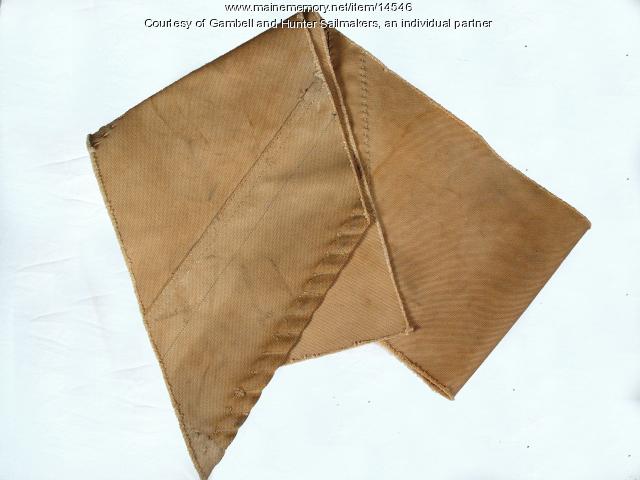Keywords: sail
Item 14520
Hand-made canvas sail seam sample, 2003
Courtesy of Gambell and Hunter Sailmakers, an individual partner Date: 2003 Location: Camden Media: Cotton
Item 14546
Fragment of a hand-made canvas sail, ca. 1930
Courtesy of Gambell and Hunter Sailmakers, an individual partner Date: circa 1930 Location: Camden Media: Canvas
Item 86856
Tin Shop and Storage, Portland Pier, Portland, 1924
Owner in 1924: Proprietors of Portland Pier Use: Tin Shop and Storage
Item 37310
158 Commercial Street, Portland, 1924
Owner in 1924: James H McDonald Use: Store & Storage
Exhibit
Camden has been home to generations of fishermen, shipbuilders, sailmakers, and others who make their living through the sea. The lives of two Camden sailmakers, who were born nearly a century apart, became entwined at a small house on Limerock Street.
Exhibit
The Schooner Bowdoin: Ninety Years of Seagoing History
After traveling to the Arctic with Robert E. Peary, Donald B. MacMillan (1874-1970), an explorer, researcher, and lecturer, helped design his own vessel for Arctic exploration, the schooner <em>Bowdoin,</em> which he named after his alma mater. The schooner remains on the seas.
Site Page
Blue Hill, Maine - Friendship vessel, Blue Hill, 1907
"… Blue Hill Public Library Description A sailing vessel named Friendship in Blue Hill. View additional information about this item on the…"
Site Page
Thomaston: The Town that Went to Sea - Shipbuilding During and after the Civil War - 1861 to 1900
"Sail damage was guaranteed in the horrendous storms in passages around Cape Horn. The sail loft they built in 1875 still stands in its original…"
Story
Minik Wallace 1891-1918
by Genevieve LeMoine, The Peary-MacMillan Arctic Museum
The life of Minik, an Inuit person from Greenland who grew up in New York City.
Story
Water is Music
by P Leone
Throughout her life water has played an important part
Lesson Plan
Primary Sources: The Maine Shipyard
Grade Level: 9-12
Content Area: Social Studies
This lesson plan will give students a close-up look at historical operations behind Maine's famed shipbuilding and shipping industries. Students will examine primary sources including letters, bills of lading, images, and objects, and draw informed hypotheses about the evolution of the seafaring industry and its impact on Maine’s communities over time.
















